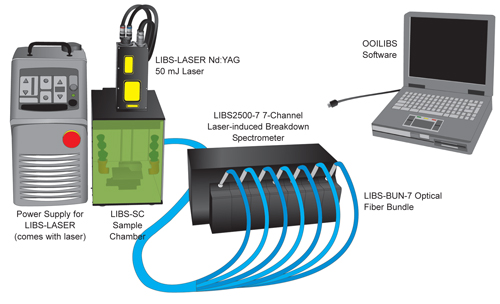您當(dāng)前的位置: 首頁(yè)-應(yīng)用中心-案例八:激光誘導(dǎo)擊穿光譜(LIBS)
案例八:激光誘導(dǎo)擊穿光譜(LIBS)
2019/08/07
Sample Setup: Laser Induced Breakdown Spectrometer

Overview
The LIBS2500 Broadband Spectrometer is a detection system for real-time elemental analysis in solids, solutions and gases. This high-resolution system provides full spectral analysis from 200-980 nm, with optical resolution of ~0.1 nm (FWHM).
Principle of Operation
An Nd:YAG pulsed laser beam is focused on the sample area. The energy of the laser generates a plasma, in which a trace amount of the sample has been ablated. As the plasma decays or cools, the plasma emits light of wavelengths that are distinct to each element. The emission is collected by a 7-fiber bundle and sent to the spectrometers for analysis.
Spectrometers
The LIBS2500-7 uses seven high-resolution spectrometers, which connects to a PC via one USB port. All seven spectrometers acquire data simultaneously; software displays the results. However, you may require a system with less than seven spectrometer channels.
Sampling Optics
The LIBS-LASER is a 50 mJ CFR Nd:YAG laser for metal and thin film samples; the LIBS-LAS200MJ is a 200 mJ CFR Nd:YAG laser for most all other materials. Both lasers are manufactured by Big Sky Laser. The LIBS-SC Sample Chamber has a manual x-y-z stage and a remote laser safety lock. Signal is collected by a fiber bundle comprising (7) 600 m UV-VIS patch cords, each with a collimating focusing lens built into the fiber termination.
Measurements
OOILIBS Software allows users to set operating parameters such as the laser Q-switch delay (the time between the firing of the laser and the beginning of spectral acquisition) and signal averaging of laser pulses.
Ordering Information




